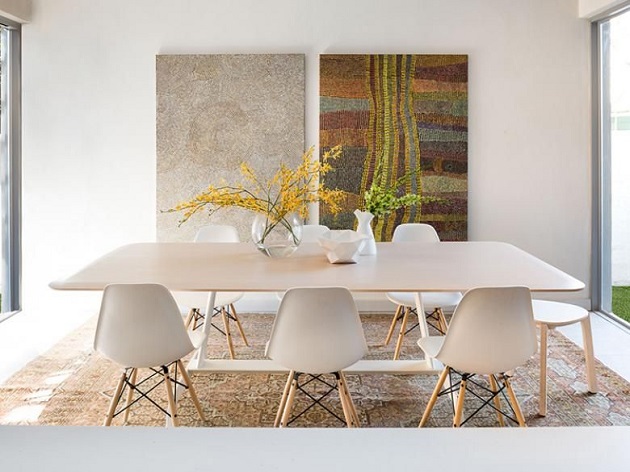Home Décor: Discover the Beauty of Australian Aboriginal Art
If choosing which art to incorporate in your home seems to be a difficult task, the good news is that you are not alone. Some people know their art and know what they want. Then, there are those who only want something to blend in nicely with the rest of their interior. Nevertheless, for most people, finding artworks for their home is quite challenging.
What your eyes find beautiful is, undoubtedly, very important. But, if you feel like everything behind the actual wall hanging (what it represents, its meaning, the artist, the story behind it) is as important as you liking the art, then Australian Aboriginal paintings are the best art to look into. They have it all: beyond their ability to fit into many interior styles with their beauty and depth, they have layers upon layers of meaning.
Aboriginal Art in Contemporary Interior Design
The main reason why Aboriginal artworks are gaining such popularity when we are talking about interior design is how incredibly visually-appealing they are. What makes them so compatible with contemporary interior designs, such as Scandi, Nordic, classic modern, minimalistic, etc. are the earth tones, the diverse palette, the patterns that look somewhat abstract, as well as the vibrancy of the art.
However, for people seeking meaning in the things they use to decorate their home with, Australian Aboriginal paintings with their beautifully intriguing compositions and patterns, are far beyond a decorative element. For many, what mainly attracts them are all the sacred stories, the diversity, the cultural meaning, the tradition, and historical and artistic significance.
They have an ability to provoke gratefulness and to ground you, with the many stories and meanings behind each piece. And when it comes to Australian homes, often inspired by international interior styles, they enrich the space and fill it with appreciation, humility, pride, tradition and history.
But when it comes specifically to your home’s appearance, Aboriginal paintings are, without a doubt, a great addition. They will also bring unparalleled warmth to your home and provide the much-desired depth of space in interior design, adding a noticeable feeling of sophistication and enlightenment.
The Art of Visual Storytelling
Art is about many things, but being a way of communication, a way to transmit messages and information is the first and foremost purpose of it. And, when it comes to Aboriginal art, this couldn’t be any truer. Not having their own written language, in a way, for Australian Aboriginal people art is how they learn about their traditions and beliefs. So, we could say that Aboriginal artworks are, in a way, written stories and teachings.
Australian Aboriginal art is considered to be the oldest living art tradition. And the patterns, the traditions, the painting techniques and the Dreamtime stories can be seen in Aboriginal art, even now, after 50.000 years. However, each Aboriginal artist, though through the use of many common symbols and iconography, bases their art on stories from their own experiences, their own life journeys.
Furthermore, though there are iconic symbols relevant to more tribes, each tribe has its own symbols with meaning. In some traditions, even colours have meaning. Artists use the techniques from their tribe and tell their stories.
Many Australian Aboriginal paintings speak about ancient stories focused on the Dreamtime – the period Australian indigenous people believe the world was created. The so-called Dreamtime art is about ancestors who travelled the land and created important sites.
One such recurring theme across Aboriginal artworks, for instance, is Women’s Dreaming, describing the journey of ancestral women across the country, from Mina Mina where the Karlangu rose up from the ground. The women collected these digging sticks and dug for bush food, creating sites as they travelled.
Contemporary Indigenous Australian Art
All artistic styles, of course, depend a lot on the artist, but we can also identify several distinct styles in Aboriginal art. With all the different symbolic language developed in different regions, many different ways of expressing were developed: X-ray painting, or rock painting, bark painting, rock carvings etc. However, in contemporary Aboriginal art, many of these have come together, with less limitation, using many colours and symbols.
In the 1970s, an artist cooperative, called Papunya Tula, started painting Aboriginal motifs using acrylic paint and a hard surface, as opposed to the traditional painting in the sand and for body adornment. This is how the popularisation of Aboriginal art begun. The artist in the cooperative were the ones that started what is now considered to be the most recognisable thing about Aboriginal painting, the so-called dot painting. The dots were an attempt to hide the spiritual symbols from the public, as to protect the sacred heritage.
However, although many details were removed or modified from Aboriginal art, the authentic symbols remained. The most common ones usually represent the same thing. The concentric circles, for instance, illustrate campsites or rock holes. The straight lines represent the routes travelled by the ancestors, while the curved ones represent water or rain.


